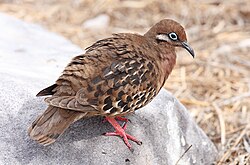

The islands are home to several endemic genera.
Birdlife International defines Endemic Bird Areas (EBAs) as places where the breeding ranges of two or more range-restricted species—those with breeding ranges of less than 50,000 km2 (19,000 sq mi)—overlap. In order to qualify, the whole of the breeding range of at least two range-restricted species must fall entirely within the EBA. [1] The entire Galápagos Islands archipelago is considered to be an Endemic Bird Area. [2] Ten Important Bird Areas, which are areas which meet a specific set of internationally agreed criteria, fall within the EBA's boundaries. [2]
| Conservation status | |
|---|---|
| EX | Extinct (1 species) |
| EW | Extinct in the wild (0 species) |
| CR | Critically endangered (2 species) |
| EN | Endangered (3 species) |
| VU | Vulnerable (12 species) |
| NT | Near threatened (3 species) |
| LC | Least concern (11 species) |
| Taxon. order [nb 1] | Common name | Picture | Scientific name | Distribution and habitat | IUCN status [nb 2] | Notes |
|---|---|---|---|---|---|---|
| 1 | Galápagos dove |  | Zenaida galapagoensis | NT IUCN | ||
| 2 | Galápagos crake |  | Laterallus spilonota | Highlands of the main islands (except Floreana) [5] | VU IUCN | Also known as Galápagos rail [6] |
| 3 | Lava gull |  | Leucophaeus fuliginosus | VU IUCN | ||
| 4 | Galápagos penguin |  | Spheniscus mendiculus | EN IUCN | ||
| 5 | Flightless cormorant |  | Nannopterum harrisi | Coastal areas on Fernandina and northern and western Isabela [7] | VU IUCN | |
| 6 | Lava heron |  | Butorides sundevalli | Rocky shores and marine lagoons on islands throughout [8] | LC IUCN | Considered by some authorities (including BirdLife International and the American Ornithological Society) to be a subspecies of the striated heron [9] [10] |
| 7 | Galápagos hawk |  | Buteo galapagoensis | All habitats throughout the islands, except on Genovesa, San Cristóbal, and Floreana [11] | VU IUCN | |
| 8 | Galápagos martin |  | Progne modesta | EN IUCN | ||
| 9 | Large-billed flycatcher |  | Myiarchus magnirostris | LC IUCN | ||
| 10 | Darwin's flycatcher |  | Pyrocephalus nanus | NT IUCN | ||
| 11 | San Cristóbal flycatcher | Pyrocephalus dubius | EX IUCN | Extinct | ||
| 12 | Galapagos mockingbird |  | Mimus parvulus | LC IUCN | ||
| 13 | Floreana mockingbird |  | Mimus trifasciatus | EN IUCN | Also known as Charles Island mockingbird | |
| 14 | Hood mockingbird |  | Mimus macdonaldi | VU IUCN | Also known as Española mockingbird | |
| 15 | San Cristóbal mockingbird |  | Mimus melanotis | NT IUCN | Also known as Chatham mockingbird | |
| 16 | Large ground finch |  | Geospiza magnirostris | LC IUCN | ||
| 17 | Medium ground finch |  | Geospiza fortis | LC IUCN | ||
| 18 | Small ground finch |  | Geospiza fuliginosa | LC IUCN | ||
| 19 | Genovesa ground finch |  | Geospiza acutirostris | VU IUCN | ||
| 20 | Sharp-beaked ground finch |  | Geospiza difficilis | LC IUCN | ||
| 21 | Vampire ground finch |  | Geospiza septentrionalis | VU IUCN | ||
| 22 | Common cactus finch |  | Geospiza scandens | LC IUCN | ||
| 23 | Española cactus finch |  | Geospiza conirostris | VU IUCN | ||
| 24 | Genovesa cactus finch |  | Geospiza propinqua | VU IUCN | ||
| 25 | Vegetarian finch |  | Platyspiza crassirostris | LC IUCN | ||
| 26 | Large tree finch |  | Camarhynchus psittacula | VU IUCN | ||
| 27 | Medium tree finch |  | Camarhynchus pauper | CR IUCN | ||
| 28 | Small tree finch |  | Camarhynchus parvulus | LC IUCN | ||
| 29 | Woodpecker finch |  | Camarhynchus pallidus | VU IUCN | ||
| 30 | Mangrove finch |  | Camarhynchus heliobates | CR IUCN | ||
| 31 | Green warbler-finch |  | Certhidea olivacea | VU IUCN | Sometimes considered conspecific with the grey warbler-finch [12] | |
| 32 | Grey warbler-finch |  | Certhidea fusca | LC IUCN |